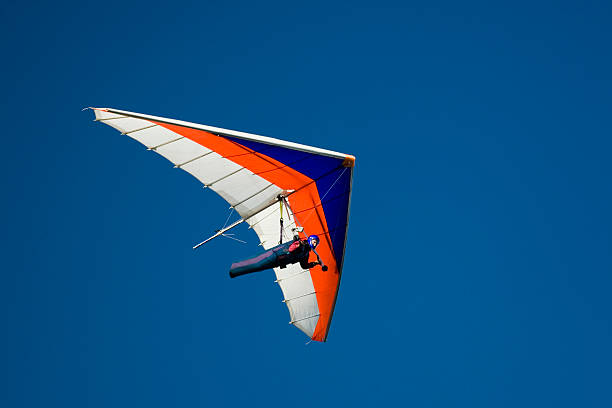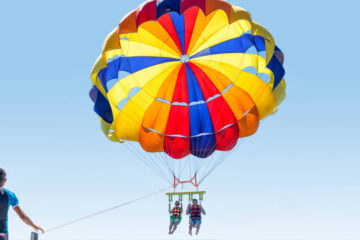Teach Yourself How to Hang Glide

by Nevio Gardasanic 04/20/2022
Hang gliding is a mind-blowing, fun, high-flyer sport that involves flying a lightweight, motorless glider across an open-air space. You’ll need to go on an elevated area such as a peak or hilltop to launch one. Then run with the craft before you take to the air. Once in the air, the glider maintains itself in the sky by rising air masses into its air pockets, also known as thermals.
Your body hangs under the craft; hence the name ‘hang glide. You use straps to harness yourself to the glider. To steer the glider, you’ll have to shift your weight to the direction you want to move. Sounds interesting? But you need to be well-secured to enjoy the entire experience safely.
So far, as a beginner, you may think hang gliding is complex. It’s not. You should grasp the ropes of hang gliding within 30 days of your self-taught lessons. You only need to follow the details illustrated in this guide.
Today, hang gliders can navigate various areas for long distances. Thanks to the more versatile materials and advanced technology used in making the hang gliders. Some pilots have fun performing acrobatic stunts in the sky as they entertain the onlookers.
A Step-by-Step Guide on How to Hang Glide
Do you feel like hang gliding appeals to your adrenaline but have no idea how to do it? Don’t fret; keep it here for a step-by-step guide on hang gliding.
Step 1: Gather the Necessary Materials
Before starting your learning journey, you’ll need to collect all the required things. You cannot learn without the necessary items and equipment. Ensure you have;
• Hang glider
• Lightweight and flexible boots
• Good quality helmet to protect your head if you fall
• A tough and flexible harness
• A reliable flying suit for comfort and insulation
• A radio to communicate with other gliders or people on the ground
• A variometer to gauge vertical speed
• A GPS to track your aerial route. People on the ground can also track you.
Step 2: Look for an Elevated Place
With all the required items ready, look for an open, elevated place with ample space for practice. It’s also essential to consider the weather every time you go out for practice. Choose days with calm winds.
Step 3: Put on a Harness and Helmet
They are for your safety. You never know when you need these safety gear.
Step 4: Connect to the Glider
After safeguarding yourself, connect to the glider. Double-check if you’ve done it correctly and securely by hanging. It’s called a hang check.
Step 4: Pick Up the Glider
After you hang check, pick up the glider. The best way to do this is by your arms resting outside the glider’s control frame to the point where they meet your shoulders. It might take a few trials to find the best position for you. Most people feel awkward and uncomfortable. But eventually, it becomes better, and you can hold the glider with a loose grip.
Step 5: Run Into the Wind
When you manage to lift the glider comfortably, make it balance. In that stable state, run into the wind but over flat ground. Begin by walking, then jogging, and finally running. Always keep your head up and focused on the target. Also, keep your eyes on where you’re going.
Mostly, it doesn’t work out with the first attempt. So don’t feel discouraged. Keep practicing until you grasp the art. Then start running downhill or from an elevated area downwards.
Step 6: Learn to Control the Glider
The glider is ready to fly when you make it fine through running. After mastering the running art, it’s time to know how to control the glider as it can start elevating and going in various directions.
Hang gliders become controlled by shifting your weight. If you want to move right, shift your body to the right. The same case applies to steering the glider on the left, upwards, or down.
You push your weight forward to speed up your glider and backward to slow it down and land. Use the wheels to land for safety. It also helps you to focus on the flying and keep things simple.
Step 7: You Are Ready To Fly
Now that you’ve successfully connected yourself to the glider, have picked it, run successfully, and can control it, it’s time for you to fly!
Step 8: Keep on Practicing
Practice makes perfect. Keep repeating all the steps until you fly like a pro!
Advantages of Hang Gliding
Despite having a flying passion and tempting your guts, there are other excellent reasons to inspire you to venture into hang gliding. They include;
i. Increased Mental Alertness
Flying on your glider requires optimal concentration for safety reasons. You also need to enjoy the ride and the beautiful scenery. Hang gliding will help you coordinate all of these simultaneously, improving your mental alertness.
ii. Strengthens Arm Muscles
Do you wonder why hang gliders have strong hands? Here’s the deal.
You require your arms to hold on to your glider’s wing. Gliding demands much from your hands. But this shouldn’t scare you away because as time passes by, your arms develop stronger muscles to help adapt to the gliding stress.
iii. Stress Reduction
While up there in the sky, you have no time for mental stress. Fresh air blasts clear your heavy mind and keep you refreshed. Beautiful views also sway you out of your current mental issues. Don’t forget the annoying cobwebs. You will have fun trying to keep them off your way.
Conclusion
As illustrated above, hang gliding isn’t complex a hobby as many think. With the right guidance and determination, it’s simple to learn. It also comes with several benefits. The process of learning how to do it yourself can be nervous. But you get used to it with more practice.
When you learn the hang gliding skills, the reward is worth it. You can navigate higher and longer distances. Besides, it’s an amazing experience.
If you want to go beyond being just a beginner at this or any other skill, and work toward developing a real mastery, then you are going to need a deeper and more powerful strategy. What you need is a way to hack your brain so you can develop a winning mindset.
A winning mindset is a state of mind that allows you to enter a flow state at will. You do this by programming your subconscious mind.
Believe it or not, most of what you do throughout an average day is NOT freely chosen by your normal waking consciousness even though it may seem that way. The truth is that most of what you do on a day-to-day basis is done on autopilot. An example of this would be when you’re driving your car and as you do so you get bored and begin daydreaming. Before you know it, you find yourself several miles further down the road with absolutely NO memory of having driven those last several miles.
So, who exactly was driving while your waking consciousness was in la-la land, and how exactly did you manage to avoid an accident? Your subconscious mind was in control. You already spent years programming your subconscious with how to deal with a broad range of possible driving scenarios and thus it had no trouble taking the wheel while your waking consciousness took a little break. In other words, you were able to take effective actions without having to THINK about them.
The same way you programmed your subconscious to drive, you can also program it to automatically take successful actions toward mastering any other skill you decide that you want to learn. CLICK HERE to learn a proven, step-by-step formula to help you attain mastery at any skill you choose and achieve everything in life.
amazines.com







No Comment